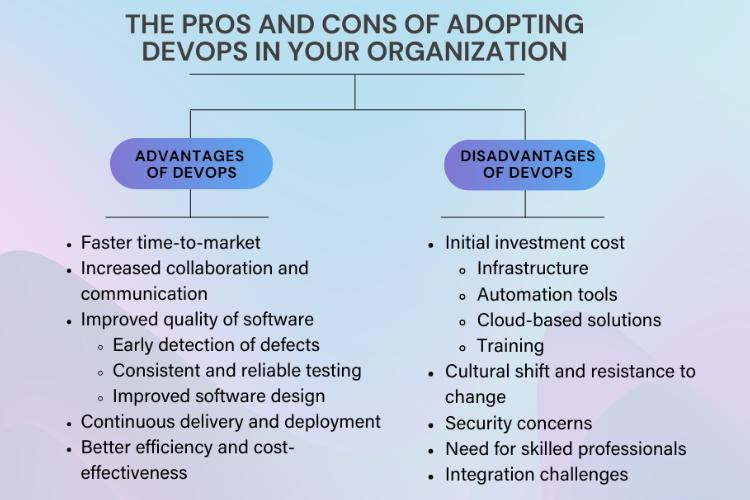DevOps is a prevalent software development methodology that prioritizes collaboration, communication, and integration between development and operations teams. Its implementation reduces development timelines, enhances quality, and increases customer satisfaction, thereby accelerating the delivery of software.
DevOps has grown in popularity, but you need to weigh its pros and cons to decide if it suits your company. We will assess the advantages and disadvantages of DevOps and offer instances of both prosperous and problematic deployments to assist you in determining whether to adopt it.
Introducing DevOps
The DevOps methodology merges development and operations teams to foster collaboration and enhance the efficiency of software application delivery. The technique automates the software development process from coding to testing to deployment to speed up delivery.
DevOps originated to bridge the divide between development and operations teams, which were traditionally divided into separate silos with distinct objectives. “DevOps” was invented by Patrick Debois in 2009. He founded DevOpsDays in Ghent, Belgium, as an IT consultant. Since then, DevOps has become a crucial part of contemporary software development.

5 Advantages of DevOps
DevOps has several advantages, leading to its widespread adoption in the software development industry. Let’s examine DevOps’ advantages and how they may benefit your business.
1. Faster time-to-market
DevOps reduces time-to-market by speeding up software development. By automating and simplifying the software delivery pipeline, DevOps enables organizations to release software more quickly, respond rapidly to changing market demands, and gain a competitive edge.
DevOps achieves this by breaking down traditional silos between development and operations teams, allowing continuous collaboration and communication. This approach reduces delays and costs by identifying and correcting faults early in development.
Ultimately, DevOps helps companies produce software quicker and more efficiently.
2. Increased collaboration and communication
DevOps helps development and operations teams work together to provide high-quality software quickly. This collaborative approach encourages openness and shared accountability as teams discover and resolve difficulties early in development.
DevOps aligns goals and objectives by breaking down the conventional barriers between development and operations, resulting in a more efficient and successful software delivery pipeline. This stronger cooperation and communication help guarantee that the product satisfies customer needs and provides a pleasant user experience.
3. Improved quality of software
DevOps emphasizes automated testing and continuous integration to improve the quality of software. Automation testing involves using tools and scripts to perform tests automatically without human intervention. Continuous integration requires merging code changes into a common repository and running automated tests to ensure compatibility with the codebase. Here’s how these practices improve software quality:
- Early detection of defects: Automated testing and continuous integration help identify defects early in the development cycle. By catching issues before they make it to production, developers can address them before they become bigger problems.
- Consistent and reliable testing: Automated testing eliminates human mistakes and assures consistency. This enhances test results and helps find and solve faults.
- Improved software design: Automated testing and continuous integration encourage developers to write modular, testable code. This results in better software design, with fewer dependencies and easier maintenance.
4. Continuous delivery and deployment
Continuous delivery and deployment, the fourth advantage of DevOps, involve the automated and continuous release of software updates and features.
This approach allows organizations to rapidly and reliably deliver software changes to customers without compromising quality or stability. Continuous delivery involves the automated build, testing, and deployment of code to a production-like environment, where it is ready for deployment.
Continuous deployment takes the process one step ahead by automatically releasing code modifications to the production environment after they have undergone all quality checks and tests successfully.
Adopting continuous delivery and deployment enables organizations to release software updates at a higher frequency, promptly respond to customer feedback, and maintain a competitive edge.
5. Better efficiency and cost-effectiveness
DevOps is recognized for automating manual activities. DevOps can help companies save money and boost ROI by automating these operations.
With DevOps, development and operations teams can spend more time on creative tasks that drive innovation rather than focusing on mundane tasks that can be automated.
DevOps also promotes cloud-based services and infrastructure, which can save money compared to on-premise infrastructure. DevOps can make businesses more competitive and nimble by cutting costs and enhancing productivity.
5 Disadvantages of DevOps
DevOps offers many benefits, but consider its downsides before using it in your company. Some of the disadvantages of DevOps include:
1. Initial investment cost
Implementing DevOps requires a significant initial investment in resources, tools, and training. Some of the considerations that affect DevOps’ initial cost are:
- Infrastructure: To enable DevOps, organizations may need to buy new servers, storage, and network gear.
- Automation tools: DevOps relies heavily on automation tools to automate the software delivery process. Organizations may need to purchase or develop new automation tools to support their DevOps environment.
- Cloud-based solutions: Cloud-based DevOps solutions offer scalability, flexibility, and cost-effectiveness. These solutions are costly, especially for small businesses.
- Training: DevOps requires new skills and knowledge for development and operations teams. Organizations may need to invest in training programs to ensure employees possess the required skills to support the DevOps environment.
Overall, the initial investment cost of implementing DevOps can be significant, and organizations need to carefully consider their budget and resource allocation before adopting this approach.
2. Cultural shift and resistance to change
DevOps demands a culture change, which might be difficult. Development and operations teams traditionally work in silos and seldom collaborate. DevOps breaks down silos and fosters cooperation, transparency, and shared accountability.
Both teams may fight this cultural change. Management, communication, and team structure may need to be altered.
To deploy DevOps, organizations must invest time and money in developing a supportive culture and tackling change resistance.
3. Security concerns
One of the potential disadvantages of DevOps is security. DevOps increases security risks due to automation and continuous integration.
For instance, automated scripts can contain coding errors that can be exploited by hackers.
Additionally, continuous integration and deployment can increase the risk of unauthorized access to sensitive data.
Therefore, organizations must integrate security measures into every stage of development to reduce these risks. This can include implementing secure coding practices, conducting regular security audits, and providing security training to DevOps teams.
By taking these steps, organizations can prevent data breaches and other security issues in their DevOps environments.
4. Need for skilled professionals
One of the primary hurdles in implementing DevOps is the requirement for proficient experts who can handle the intricate automation tools, agile development methodologies, and cloud platforms that are integral to this approach.
Hiring and training these specialists is tough, especially in talent-short areas.
DevOps requires knowledge of Docker, Kubernetes, Jenkins, Ansible, cloud computing, and agile methodologies. Without skilled professionals, organizations may struggle to implement DevOps effectively, impacting the quality of software and the overall development process.
Therefore, attracting and retaining skilled DevOps professionals is crucial for successful implementation.
5. Integration challenges
DevOps involves integrating different tools, processes, and teams to streamline the software development process. However, integrating these elements can be challenging and time-consuming.
For example, integrating the development environment with the operations environment can require significant effort to ensure the two environments work seamlessly together. Integration issues can delay development and lower program quality.
Organizations must carefully plan and execute the integration process, and they may need to invest in specific tools and talent to succeed.
Case studies/examples
Below are two instances of organizations that have implemented DevOps:
1. Successful implementation: Netflix
Netflix is a streaming platform that serves over 232.5 million subscribers worldwide. Netflix implemented DevOps to minimize the time-to-market for new products and enhance software quality to accommodate its fast-increasing client base.
Netflix deployed faster and better, utilizing automation and continuous delivery. The company also created a culture of collaboration between the development and operations teams, which helped it identify and resolve issues quickly.
2. Challenging implementation: Target
Target, a large retail company, attempted to implement DevOps to improve its software delivery process. However, the company faced several obstacles, including a lack of alliance between the development and operations teams, insufficient automation, and resistance to change.
Target’s attempt to adopt DevOps failed to produce the desired results, and the company eventually had to scale back its efforts. The company’s experience highlights the importance of carefully planning and executing a DevOps implementation and addressing cultural barriers that may impede its success.
Assessing the advantages and disadvantages of DevOps.
DevOps is an approach to software development and delivery that improves efficiency, collaboration, and time-to-market.. Nevertheless, it also entails certain drawbacks such as the expense of the initial investment, resistance to change and cultural shifts, security risks, the necessity for expert professionals, and the difficulties involved in integration.
Hence, DevOps is important to thoroughly assess the particular needs and objectives of the organization and individuals before adopting DevOps to determine whether it is the appropriate methodology for the company. With proper planning, training, and implementation, companies can successfully leverage the benefits of DevOps while minimizing potential challenges. DevOps adoption should be based on carefully analyzing its advantages and disadvantages and the company’s needs.






